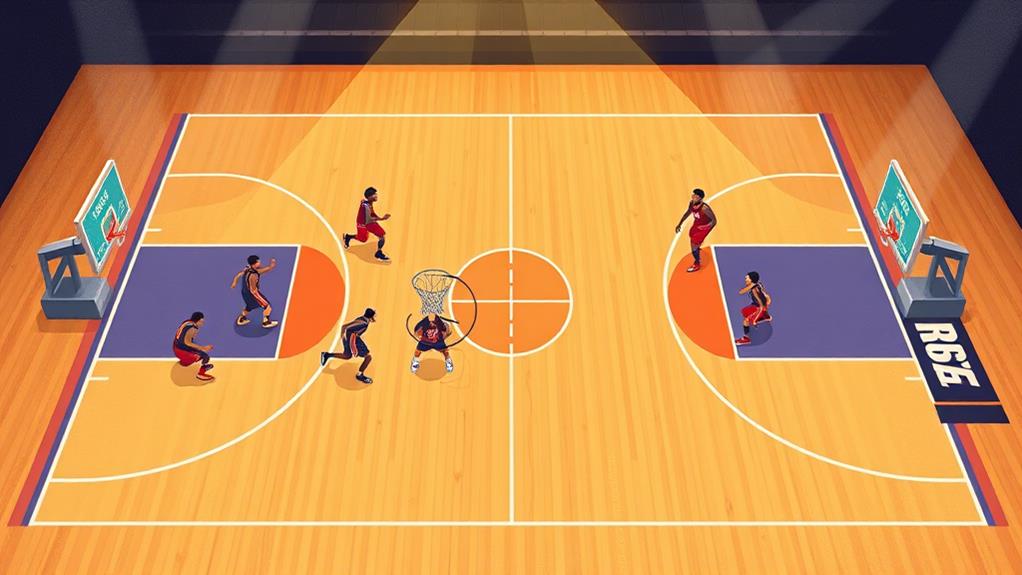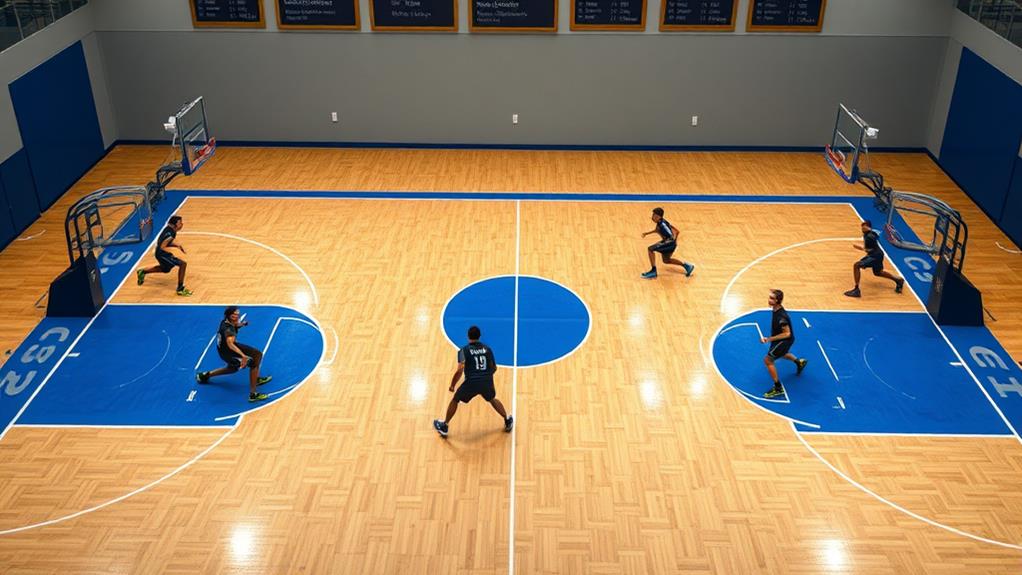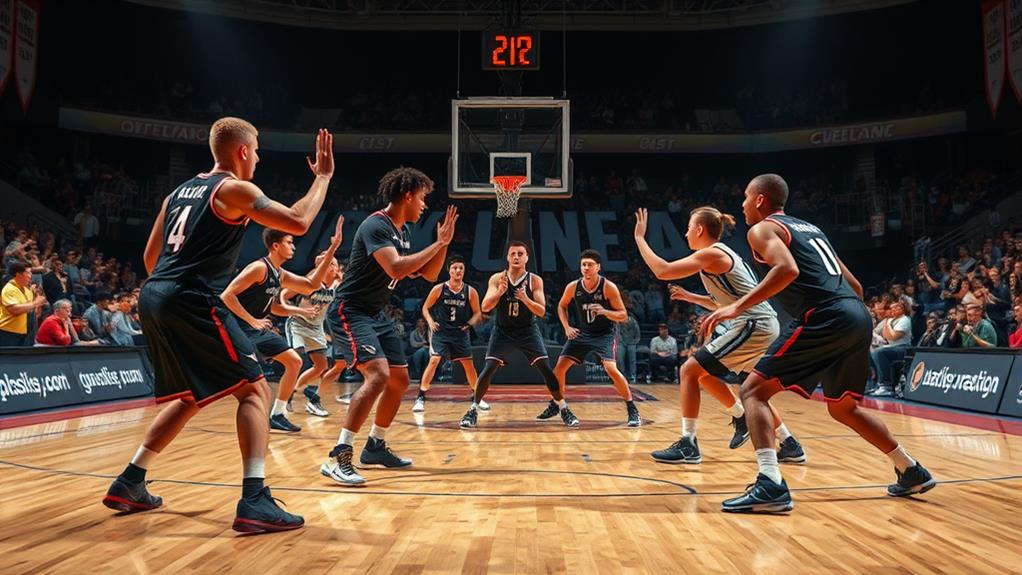
A Comprehensive Guide to the Pack Line Defense
September 14, 2024The Pack Line Defense is a strategic man-to-man tactic focused on maintaining a tight structure. You keep your defenders within a 16-foot area to limit dribble penetration and force lower-percentage shots. Effective communication and teamwork are critical for successful help defense. This approach can greatly lower your opponents' scoring, often holding them under 40% shooting. However, improper positioning can lead to vulnerabilities, especially from three-point range. To execute this defense effectively, you'll need patience and discipline. Stick around, and you'll discover practical drills and specialized strategies to help your team master this defensive technique.
Overview of Pack Line Defense
The Pack-Line defense is a highly strategic man-to-man approach that focuses on creating a tight, compact formation around the basket. This defensive strategy requires players to stay within a 16-foot area, effectively preventing dribble penetration and forcing opponents to take lower-percentage outside shots.
As a defender, you'll need to maintain a ball-you-man stance, ensuring you're always aware of both the ball and your assigned player. This approach not only emphasizes individual skill but also embodies the principles of promoting social equality and inclusivity through teamwork and mutual respect among players.
Communication and teamwork are essential in Pack-Line defense. All defenders, except the one guarding the ball-handler, must position themselves to provide help defense, effectively covering driving lanes and protecting the paint. This coordination not only stifles offensive opportunities but also greatly lowers opponents' field goal percentages.
Key principles include quick closeouts on shooters and boxing out to secure rebounds after missed shots. By emphasizing these aspects, you can dominate the boards and limit second-chance scoring opportunities.
Additionally, the structure of the Pack-Line defense is particularly effective against offenses that rely on back-door cuts, ensuring that all cutters remain adequately covered. Implementing these strategies will help you create a formidable defensive unit.
Advantages of Pack Line Defense
The Pack-Line defense's primary advantage is its ability to deny dribble penetration, forcing opponents to take tougher shots. By positioning defenders close to the basket, you can effectively lower your opponent's field goal percentage.
This strategy not only disrupts offensive flow but also creates a challenging environment for drivers and shooters alike.
Additionally, effective marking and pressing can enhance the Pack-Line defense by creating opportunities for counter-attacks and regaining possession quickly.
Denies Dribble Penetration
In basketball, denying dribble penetration is essential for a strong defense, and the Pack-Line Defense excels at this. By positioning four defenders within 16 feet of the basket, you create a barrier that effectively denies driving lanes to offensive players. This setup discourages penetration, forcing opponents to rely on perimeter shots, which often results in lower shooting percentages.
As a result, your defense minimizes open driving opportunities, compelling ball handlers to navigate through traffic rather than toward the rim. This approach increases the likelihood of contested shots, making it tougher for offensive players to score.
Additionally, the Pack-Line Defense reduces the effectiveness of back-door cuts since defenders are always ready to help and disrupt offensive flow.
When you implement this strategy, you not only protect the paint but also enhance your team's overall defensive effectiveness. By consistently denying dribble penetration, you force opponents into low-percentage shots, considerably impacting their ability to score.
Fundamentally, the Pack-Line Defense is an effective method for maintaining control over the game and limiting your opponent's scoring opportunities.
Lowers Field Goal Percentage
Utilizing the Pack-Line Defense can greatly lower your opponent's field goal percentage, often forcing them into tough, contested shots. By positioning your defenders within 16 feet of the basket, you create a formidable barrier against dribble penetration. This strategy emphasizes help defense, considerably reducing high-percentage shot opportunities for your rivals.
Here are some key advantages of this defensive formation:
- Forces opponents into difficult, contested shots
- Limits high-percentage scoring chances
- Reduces the likelihood of back-door cuts
- Lowers opponent scoring average by 10-15 points per game
- Maintains your team's shooting efficiency
Statistical analysis shows that teams using the Pack-Line defense often hold opponents to under 40% shooting from the field.
By compelling offensive teams to rely on long-range attempts, you effectively disrupt their rhythm and control the game's pace. This approach not only enhances your team's defensive capabilities but also elevates your overall performance.
Implementing the Pack-Line defense can be a game-changer, leading to considerable improvements in both your opponent's shooting efficiency and your defensive prowess.
Weaknesses of Pack Line Defense

While the Pack-Line defense has its strengths, it also comes with notable weaknesses that you need to take into account.
For instance, improper positioning can lead to breakdowns in coverage, allowing attackers to exploit gaps in the defense.
You'll find that its design can leave your team vulnerable to open three-point shots if players don't close out quickly enough maintaining defensive shape.
Additionally, maintaining coordination and patience is essential; otherwise, you risk creating gaps that opponents can exploit.
Three-Point Vulnerability
How can teams effectively exploit the Pack-Line defense's weaknesses? One of the most glaring vulnerabilities lies in its perimeter defense, particularly against three-point shots. When defenders prioritize help positions, they sometimes leave shooters wide open, creating high-percentage shooting opportunities.
Here are five strategies to capitalize on this flaw:
- Quick ball movement can shift defenders and create open looks.
- Utilizing skilled shooters who can make three-point shots consistently.
- Exploiting dribble penetration to draw defenders in, opening up outside shots.
- Maintaining awareness of the shot clock, forcing the defense into rushed decisions.
- Spacing the floor to stretch the defense and create lanes for shooters.
Without a shot clock, offenses can take their time, effectively working the ball around until they find the perfect shot.
If players become too focused on preventing dribble penetration, they risk neglecting perimeter defense, allowing for a significant increase in three-point shooting percentage.
To conclude, understanding and exploiting these vulnerabilities can turn a game in your favor.
Coordination Challenges
Coordination is essential in executing the Pack-Line defense, and any breakdown can lead to open scoring opportunities for the offense. If players don't maintain strong communication, they risk missing rotations and defensive assignments. This lack of execution creates gaps that offensive teams can exploit, especially when they're patient with their ball movement.
Discipline is vital; chasing steals can pull you out of position, undermining the defense's integrity. You'll need to stay disciplined and resist the urge to gamble, as this can lead to easy baskets.
Remember, the Pack-Line defense is particularly vulnerable to three-point shots. If you fail to close out quickly and effectively on shooters, you'll give the offense an advantage.
In leagues without a shot clock, the lack of time pressure only amplifies these challenges. Offenses can take their time, making it even more important for you to stay coordinated and communicate effectively.
A single breakdown can turn a solid defensive stand into a scoring opportunity for the other team. Focus on maintaining your discipline, communication, and coordination to minimize these risks and strengthen your Pack-Line defense.
Patience Requirement
Patience is a cornerstone of the Pack-Line defense, and players must cultivate this quality to minimize weaknesses in their strategy. Without patience, you risk chasing the ball, which can lead to defensive breakdowns and easy scoring opportunities for your opponents. This discipline is essential to maintaining the team's defensive structure.
To foster patience in your gameplay, focus on the following:
- Stay disciplined: Resist the urge to overcommit to steals.
- Maintain communication: Talk to your teammates about your roles and responsibilities.
- Emphasize teamwork: Work together to uphold defensive integrity.
- Understand positioning: Keep your place within the pack line to avoid gaps.
- Practice restraint: Focus on containing the offensive player instead of chasing.
Youth teams especially need to develop this patience, as younger players are often more tempted to chase the ball.
By enhancing your patience, you strengthen not only your individual performance but also the overall effectiveness of the Pack-Line defense.
Key Principles of Pack Line Defense
Employing a compact defensive structure, the Pack-Line defense revolves around key principles that enhance team effectiveness. First, players must maintain their positions within a 16-18 foot line from the basket, which is essential for executing effective help defense. Strong communication among teammates guarantees that everyone is aware of their defensive responsibilities, especially as the ball moves around the court.
By emphasizing pressure and cover, defenders can disrupt the opponent's flow and maintain a strong defensive presence. The Pack-Line defense is designed to force opponents into taking low-percentage shots. This emphasizes contesting shots over chasing aggressive steals, allowing your team to control the game's tempo. Each defender stays connected to their assigned offensive player while remaining ready to provide help, reinforcing the team-oriented approach fundamental to this system.
Patience plays an important role in this defensive strategy. You need to resist the temptation to chase the ball, focusing instead on maintaining your assigned position and responsibilities within the pack.
Specialized Defensive Strategies

Specialized defensive strategies are vital for maximizing the effectiveness of the Pack-Line defense. By employing tailored techniques, you can strengthen your team's performance and disrupt the opposing offense. Here are some key strategies to take into account:
- Baseline Defense: Prevent offensive players from driving along the baseline and force them toward help defenders. Incorporating Defensive Stance Drills for Beginners can enhance your team's agility and positioning.
- Guarding the Post: Use techniques like 3/4 fronting to deny entry passes and decide when to double-team based on the game situation.
- Defending Screens: Navigate screens effectively without switching, maintaining close proximity to avoid easy shots.
- Rebounding Techniques: Focus on box out techniques and early positioning to secure possession after missed shots.
- Transition Defense: Quickly shift your defensive positioning to thwart fast breaks and regain control.
Strong team communication is essential for all these strategies. It guarantees everyone understands their roles, maintains defensive positioning, and reacts effectively to offensive maneuvers.
Practical Drills for Implementation
To effectively implement the Pack-Line defense, your team needs practical drills that sharpen both on-ball pressure and off-ball positioning.
Start with "Close-Outs" drills, which emphasize quickly recovering to assigned players while contesting shots. This helps reinforce proper technique and enhances communication among teammates, similar to the Speed and Agility Drills that improve maneuverability on the field.
Next, incorporate "Shell Drills" to practice defensive rotations and help principles in a controlled setting. These drills allow players to better respond to offensive movements, ensuring everyone understands their role within the 16-foot pack line.
Don't forget about "Transition Defense Drills." These are essential for developing the habit of sprinting back to prevent easy scoring opportunities, maintaining your team's defensive integrity even during fast breaks.
Conclusion
In wrapping up, the Pack Line Defense can be your secret weapon on the court, turning your team into a formidable wall. By understanding its key principles and practicing specialized drills, you'll cultivate a defense that feels like an unbreakable fortress. While it has its flaws, mastering this strategy can elevate your game and keep opponents guessing. So, lace up your shoes, hit the practice floor, and watch your defensive prowess soar!


